科特勒市场营销第十一章习题与答案
- 格式:pdf
- 大小:16.15 KB
- 文档页数:16
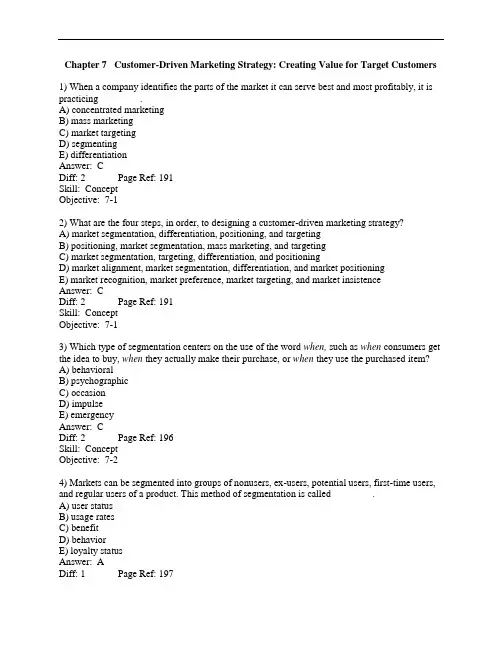
Chapter 7 Customer-Driven Marketing Strategy: Creating Value for Target Customers 1) When a company identifies the parts of the market it can serve best and most profitably, it is practicing ________.A) concentrated marketingB) mass marketingC) market targetingD) segmentingE) differentiationAnswer: CDiff: 2 Page Ref: 191Skill: ConceptObjective: 7-12) What are the four steps, in order, to designing a customer-driven marketing strategy?A) market segmentation, differentiation, positioning, and targetingB) positioning, market segmentation, mass marketing, and targetingC) market segmentation, targeting, differentiation, and positioningD) market alignment, market segmentation, differentiation, and market positioningE) market recognition, market preference, market targeting, and market insistenceAnswer: CDiff: 2 Page Ref: 191Skill: ConceptObjective: 7-13) Which type of segmentation centers on the use of the word when, such as when consumers get the idea to buy, when they actually make their purchase, or when they use the purchased item?A) behavioralB) psychographicC) occasionD) impulseE) emergencyAnswer: CDiff: 2 Page Ref: 196Skill: ConceptObjective: 7-24) Markets can be segmented into groups of nonusers, ex-users, potential users, first-time users, and regular users of a product. This method of segmentation is called ________.A) user statusB) usage ratesC) benefitD) behaviorE) loyalty statusAnswer: ADiff: 1 Page Ref: 197Objective: 7-25) Consumers can show their allegiance to brands, stores, or companies. Marketers can use this information to segment consumers by ________.A) user statusB) loyalty statusC) store typeD) brand preferenceE) usage rateAnswer: BDiff: 1 Page Ref: 197Skill: ConceptObjective: 7-26) Consumer and business marketers use many of the same variables to segment markets. Business marketers use all of the following EXCEPT ________.A) operating characteristicsB) purchasing approachesC) situational factorsD) personal characteristicsE) brand personalitiesAnswer: EDiff: 3 Page Ref: 198Skill: ConceptObjective: 7-27) When the size, purchasing power, and profiles of a market segment can be determined, it possesses the requirement of being ________.A) measurableB) accessibleC) substantialD) actionableE) observableAnswer: ADiff: 2 Page Ref: 200Skill: ConceptObjective: 7-28) When a business market segment is large or profitable enough to serve, it is termed ________.A) measurableB) accessibleC) substantialD) actionableE) differentiableAnswer: CDiff: 2 Page Ref: 200Objective: 7-29) To evaluate the different market segments your company serves, you would look at all of these factors EXCEPT which one?A) segment sizeB) segment growthC) segment structural attractivenessD) company valuesE) company resourcesAnswer: DDiff: 3 Page Ref: 201Skill: ConceptObjective: 7-310) Which of the following is NOT one of the reasons a segment would be less attractive to a company?A) strong competitorsB) substitute productsC) concentrated marketD) power of buyersE) power of suppliersAnswer: CDiff: 2 Page Ref: 201Skill: ConceptObjective: 7-311) The 55-year-old baby boomers share common needs in music and performers. When a music company decides to serve this group, the group is called a(n) ________.A) market segmentB) target marketC) well-defined marketD) differentiated marketE) undifferentiated marketAnswer: BDiff: 1 Page Ref: 201Skill: ConceptObjective: 7-312) When New Port Shipping uses segmented marketing, it targets several segments and designs separate offers for each one. This approach is called ________ marketing.A) undifferentiatedB) differentiatedC) targetD) individualE) nicheAnswer: BDiff: 2 Page Ref: 202Skill: ConceptObjective: 7-313) Developing a strong position within several segments creates more total sales than ________ marketing across all segments.A) undifferentiatedB) differentiatedC) nicheD) targetE) individualAnswer: ADiff: 3 Page Ref: 202Skill: ConceptObjective: 7-314) Using concentrated marketing, the marketer goes after a ________ share of ________.A) small。
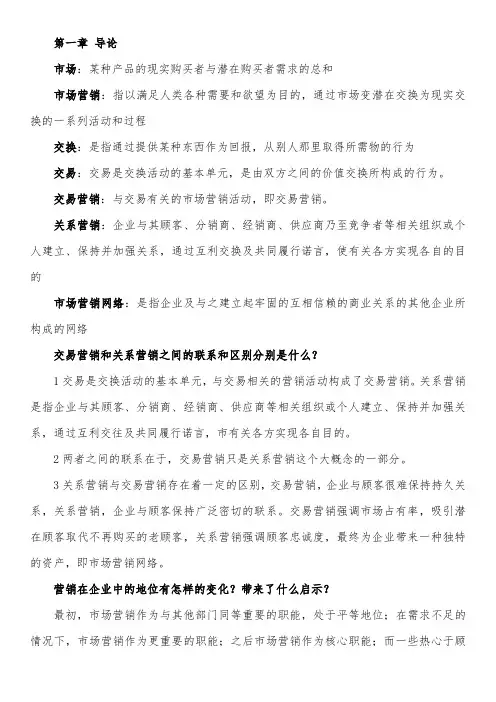
第一章导论市场:某种产品的现实购买者与潜在购买者需求的总和市场营销:指以满足人类各种需要和欲望为目的,通过市场变潜在交换为现实交换的一系列活动和过程交换:是指通过提供某种东西作为回报,从别人那里取得所需物的行为交易:交易是交换活动的基本单元,是由双方之间的价值交换所构成的行为。
交易营销:与交易有关的市场营销活动,即交易营销。
关系营销:企业与其顾客、分销商、经销商、供应商乃至竞争者等相关组织或个人建立、保持并加强关系,通过互利交换及共同履行诺言,使有关各方实现各自的目的市场营销网络:是指企业及与之建立起牢固的互相信赖的商业关系的其他企业所构成的网络交易营销和关系营销之间的联系和区别分别是什么?1交易是交换活动的基本单元,与交易相关的营销活动构成了交易营销。
关系营销是指企业与其顾客、分销商、经销商、供应商等相关组织或个人建立、保持并加强关系,通过互利交往及共同履行诺言,市有关各方实现各自目的。
2两者之间的联系在于,交易营销只是关系营销这个大概念的一部分。
3关系营销与交易营销存在着一定的区别,交易营销,企业与顾客很难保持持久关系,关系营销,企业与顾客保持广泛密切的联系。
交易营销强调市场占有率,吸引潜在顾客取代不再购买的老顾客,关系营销强调顾客忠诚度,最终为企业带来一种独特的资产,即市场营销网络。
营销在企业中的地位有怎样的变化?带来了什么启示?最初,市场营销作为与其他部门同等重要的职能,处于平等地位;在需求不足的情况下,市场营销作为更重要的职能;之后市场营销作为核心职能;而一些热心于顾客服务的企业高层管理人员主顾客作为管理职能的核心;最后,达成共识,顾客作为管理职能的核心,而市场营销作为整合性职能。
市场营销与其他职能部门不同,他是连接市场需求与企业反应的桥梁、纽带,要想有效地满足顾客需要,就必须将市场营销至于企业的中心地位。
从宏观的角度看,营销的重要性体现在哪些方面?1、市场营销在不同行业的扩散;2、推动企业重视市场营销的主要因素:销售额下降、增长缓慢、购买行为的改变、竞争的加剧和营销成本的提高;3、市场营销职能在企业中地位的变迁。
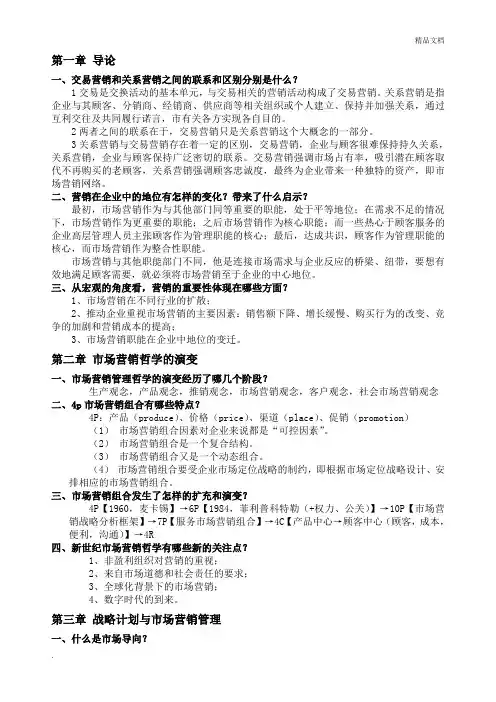
第一章导论一、交易营销和关系营销之间的联系和区别分别是什么?1交易是交换活动的基本单元,与交易相关的营销活动构成了交易营销。
关系营销是指企业与其顾客、分销商、经销商、供应商等相关组织或个人建立、保持并加强关系,通过互利交往及共同履行诺言,市有关各方实现各自目的。
2两者之间的联系在于,交易营销只是关系营销这个大概念的一部分。
3关系营销与交易营销存在着一定的区别,交易营销,企业与顾客很难保持持久关系,关系营销,企业与顾客保持广泛密切的联系。
交易营销强调市场占有率,吸引潜在顾客取代不再购买的老顾客,关系营销强调顾客忠诚度,最终为企业带来一种独特的资产,即市场营销网络。
二、营销在企业中的地位有怎样的变化?带来了什么启示?最初,市场营销作为与其他部门同等重要的职能,处于平等地位;在需求不足的情况下,市场营销作为更重要的职能;之后市场营销作为核心职能;而一些热心于顾客服务的企业高层管理人员主张顾客作为管理职能的核心;最后,达成共识,顾客作为管理职能的核心,而市场营销作为整合性职能。
市场营销与其他职能部门不同,他是连接市场需求与企业反应的桥梁、纽带,要想有效地满足顾客需要,就必须将市场营销至于企业的中心地位。
三、从宏观的角度看,营销的重要性体现在哪些方面?1、市场营销在不同行业的扩散;2、推动企业重视市场营销的主要因素:销售额下降、增长缓慢、购买行为的改变、竞争的加剧和营销成本的提高;3、市场营销职能在企业中地位的变迁。
第二章市场营销哲学的演变一、市场营销管理哲学的演变经历了哪几个阶段?生产观念,产品观念,推销观念,市场营销观念,客户观念,社会市场营销观念二、4p市场营销组合有哪些特点?4P:产品(produce)、价格(price)、渠道(place)、促销(promotion)(1)市场营销组合因素对企业来说都是“可控因素”。
(2)市场营销组合是一个复合结构。
(3)市场营销组合又是一个动态组合。
(4)市场营销组合要受企业市场定位战略的制约,即根据市场定位战略设计、安排相应的市场营销组合。

判断题F.1、市场营销学研究问题的出发点是资源的稀缺性。
F.2、根据顾客让渡价值理论,顾客总价值与顾客总成本之间的差距越小,顾客越满意。
F.3、根据市场的构成要素,市场的大小取决于人口、收入和支出三方面的大小.F.4、若用冰山来描述营销与推销的关系,营销是就是露出海平面的部分T.5、根据营销学原理,商标是品牌的一部分T.6、撇脂定价法就是在产品上市初期将价格定的较高F.7、公关促销可以在短期内刺激顾客立即采取购买行为F.8、选择分销就是制造商在某地区精心挑选几家最合适的中间商来销售其产品F.9、企业的战略计划的第一步就是规定企业目标。
F.10、市场营销组合就是用什么样的方式做广告。
T.11、产品观念对企业提高产品质量有好处,但往往导致市场营销近视。
T.12市场营销管理的实质是需求管理。
T.13、在规定企业的任务是要考虑企业的历史和周围环境的发展变化。
T.14、市场营销组合的因素对企业来说都是“可控因素”。
T.15、在波士顿矩阵中,低市场增长率和低相对市场占有率的单位是狗类战略业务单位。
T.16、若用冰山来描述营销与推销的关系,推销是就是露出海平面的部分F.17、渗透定价法就是在产品上市初期将价格定的较高T.18、个人可支配收入是指个人收入扣除个人缴纳的各种税款和非税性负担后的余额。
T.19、求名心理所产生的动机属于感情动机。
T.20、与最强的竞争对手对着干的定位策略是迎头定位,T.21、推销观念认为,只要加大产品的推销力度,产品不会没销路。
F.22、在波士顿矩阵中,高市场增长率和低相对市场占有率的单位是狗类战略业务单位。
F.23、面对市场威胁企业只有转移才能发展。
F.24、如何选择目标市场,应根据企业的实际而定,如果企业的资源雄厚,可以考虑实行集中市场营销。
F.25、从生产者观点看,随着渠道层次的增多,控制渠道所需解决的问题会减少。
T.26、多角化增长就是企业利用经营业务范围之外的市场机会,增加与现有产品业务有一定联系或毫无联系的新业务,实现跨行业经营的一种发展战略。
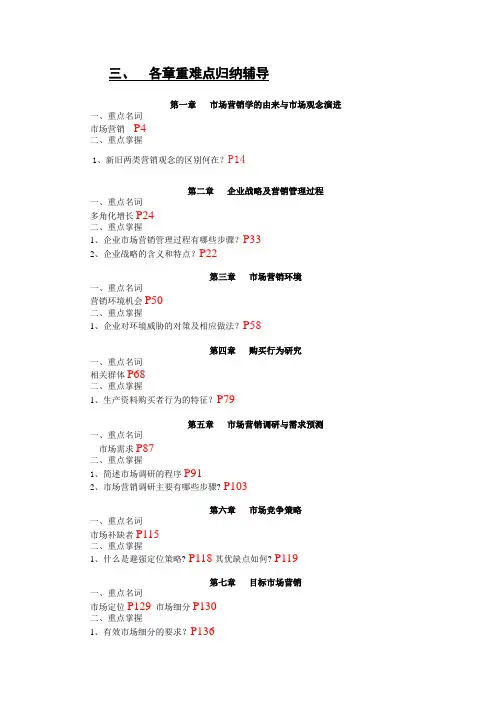
三、各章重难点归纳辅导第一章市场营销学的由来与市场观念演进一、重点名词市场营销P4二、重点掌握1、新旧两类营销观念的区别何在?P14第二章企业战略及营销管理过程一、重点名词多角化增长P24二、重点掌握1、企业市场营销管理过程有哪些步骤?P332、企业战略的含义和特点?P22第三章市场营销环境一、重点名词营销环境机会P50二、重点掌握1、企业对环境威胁的对策及相应做法?P58第四章购买行为研究一、重点名词相关群体P68二、重点掌握1、生产资料购买者行为的特征?P79第五章市场营销调研与需求预测一、重点名词市场需求P87二、重点掌握1、简述市场调研的程序P912、市场营销调研主要有哪些步骤? P103第六章市场竞争策略一、重点名词市场补缺者P115二、重点掌握1、什么是避强定位策略? P118其优缺点如何? P119第七章目标市场营销一、重点名词市场定位P129市场细分P130二、重点掌握1、有效市场细分的要求?P136第八章产品策略—产品、产品组合、品牌与包装一、重点名词商标P155第九章产品策略—产品生命周期与新产品开发一、重点掌握1、产品在成熟期的特点及营销策略主要有哪些?P1662、简述新产品开发过程的主要阶段P170第十章定价策略一、重点名词二、重点掌握1、速取定价策略和渐进定价策略各自适用于什么情况?2、企业定价的步骤有哪些?3、简述企业定价的目标有哪些?第十一章分销策略一、重点名词直销营销P196批发商业P207二、重点掌握1、分销渠道的特点和作用如何?P1972、简述直效营销的特征P1983、简述分销渠道的功能P1994、简述直效营销的主要影响因素P211第十二章网络营销一、重点名词网络营销P222市场信息P223二、重点掌握1、简述网络营销的职能P2292、简述网络营销的优势P230第十三章促销策略一、重点名词促销P240广告P247二、重点掌握1、什么是促销组合?P249影响企业促销组合决策的因素有哪些?P2502、影响促销组合的因素有哪些?P253第十四章市场营销的组织、实施与控制一、重点名词市场营销控制P274二、重点掌握1、市场营销计划一般包括哪几个方面?P277四、综合练习题(一)单项选择题1.一种观念认为:消费者可以接受任何买得到和买得起的产品,因而企业的主要任务就是努力提高效率、降低成本、扩大生产。
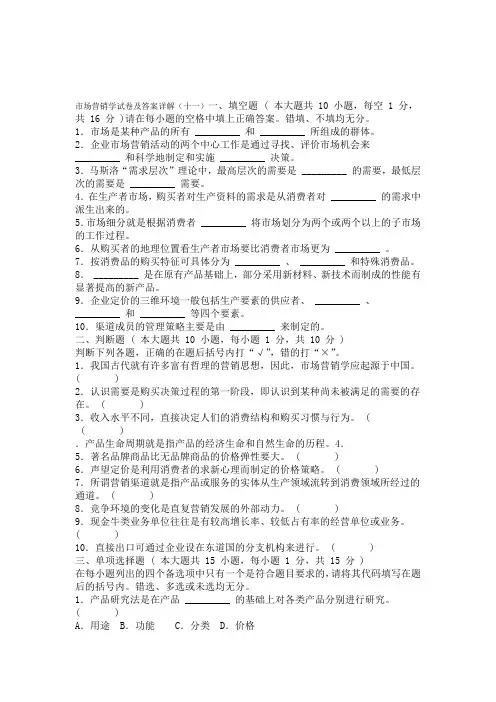
市场营销学试卷及答案详解(十一)一、填空题 ( 本大题共 10 小题,每空 1 分,共 16 分 )请在每小题的空格中填上正确答案。
错填、不填均无分。
1.市场是某种产品的所有 _________ 和 _________ 所组成的群体。
2.企业市场营销活动的两个中心工作是通过寻找、评价市场机会来_________ 和科学地制定和实施 _________ 决策。
3.马斯洛“需求层次”理论中,最高层次的需要是 _________ 的需要,最低层次的需要是 _________ 需要。
4.在生产者市场,购买者对生产资料的需求是从消费者对 _________ 的需求中派生出来的。
5.市场细分就是根据消费者 _________ 将市场划分为两个或两个以上的子市场的工作过程。
6.从购买者的地理位置看生产者市场要比消费者市场更为 _________ 。
7.按消费品的购买特征可具体分为 _________ 、 _________ 和特殊消费品。
8. _________ 是在原有产品基础上,部分采用新材料、新技术而制成的性能有显著提高的新产品。
9.企业定价的三维环境一般包括生产要素的供应者、 _________ 、_________ 和 _________ 等四个要素。
10.渠道成员的管理策略主要是由 _________ 来制定的。
二、判断题 ( 本大题共 10 小题,每小题 1 分,共 10 分 )判断下列各题,正确的在题后括号内打“√”,错的打“×”。
1.我国古代就有许多富有哲理的营销思想,因此,市场营销学应起源于中国。
( )2.认识需要是购买决策过程的第一阶段,即认识到某种尚未被满足的需要的存在。
( )3.收入水平不同,直接决定人们的消费结构和购买习惯与行为。
(( ).产品生命周期就是指产品的经济生命和自然生命的历程。
4.5.著名品牌商品比无品牌商品的价格弹性要大。
( )6.声望定价是利用消费者的求新心理而制定的价格策略。
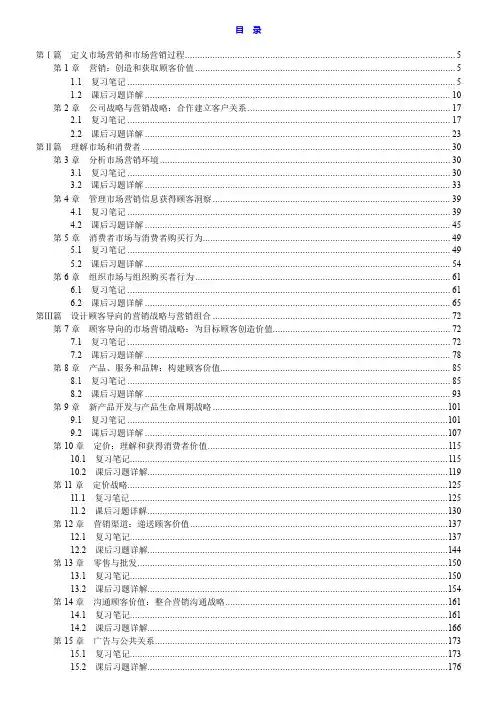
目录第Ⅰ篇定义市场营销和市场营销过程 (5)第1章营销:创造和获取顾客价值 (5)1.1复习笔记 (5)1.2课后习题详解 (10)第2章公司战略与营销战略:合作建立客户关系 (17)2.1复习笔记 (17)2.2课后习题详解 (23)第Ⅱ篇理解市场和消费者 (30)第3章分析市场营销环境 (30)3.1复习笔记 (30)3.2课后习题详解 (33)第4章管理市场营销信息获得顾客洞察 (39)4.1复习笔记 (39)4.2课后习题详解 (45)第5章消费者市场与消费者购买行为 (49)5.1复习笔记 (49)5.2课后习题详解 (54)第6章组织市场与组织购买者行为 (61)6.1复习笔记 (61)6.2课后习题详解 (65)第Ⅲ篇设计顾客导向的营销战略与营销组合 (72)第7章顾客导向的市场营销战略:为目标顾客创造价值 (72)7.1复习笔记 (72)7.2课后习题详解 (78)第8章产品、服务和品牌:构建顾客价值 (85)8.1复习笔记 (85)8.2课后习题详解 (93)第9章新产品开发与产品生命周期战略 (101)9.1复习笔记 (101)9.2课后习题详解 (107)第10章定价:理解和获得消费者价值 (115)10.1复习笔记 (115)10.2课后习题详解 (119)第11章定价战略 (125)11.1复习笔记 (125)11.2课后习题详解 (130)第12章营销渠道:递送顾客价值 (137)12.1复习笔记 (137)12.2课后习题详解 (144)第13章零售与批发 (150)13.1复习笔记 (150)13.2课后习题详解 (154)第14章沟通顾客价值:整合营销沟通战略 (161)14.1复习笔记 (161)14.2课后习题详解 (166)第15章广告与公共关系 (173)15.1复习笔记 (173)15.2课后习题详解 (176)第16章人员销售和销售促进 (182)16.1复习笔记 (182)16.2课后习题详解 (188)第17章直复营销和网络营销:建立直接顾客关系 (194)17.1复习笔记 (194)17.2课后习题详解 (199)第Ⅳ篇拓展市场营销 (207)第18章创造竞争优势 (207)18.1复习笔记 (207)18.2课后习题详解 (212)第19章全球市场 (218)19.1复习笔记 (218)19.2课后习题详解 (224)第20章可持续的市场营销:社会责任和道德 (229)20.1复习笔记 (229)20.2课后习题详解 (234)第Ⅰ篇定义市场营销和市场营销过程第1章营销:创造和获取顾客价值1.1复习笔记一、什么是市场营销市场营销即管理有价值的客户关系。
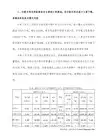
Chapter 7 Customer-Driven Marketing Strategy: Creating Value for Target Customers 1) When a company identifies the parts of the market it can serve best and most profitably, it is practicing ________.A) concentrated marketingB) mass marketingC) market targetingD) segmentingE) differentiationAnswer: CDiff: 2 Page Ref: 191Skill: ConceptObjective: 7-12) What are the four steps, in order, to designing a customer-driven marketing strategy?A) market segmentation, differentiation, positioning, and targetingB) positioning, market segmentation, mass marketing, and targetingC) market segmentation, targeting, differentiation, and positioningD) market alignment, market segmentation, differentiation, and market positioningE) market recognition, market preference, market targeting, and market insistenceAnswer: CDiff: 2 Page Ref: 191Skill: ConceptObjective: 7-13) Which type of segmentation centers on the use of the word when, such as when consumers get the idea to buy, when they actually make their purchase, or when they use the purchased item?A) behavioralB) psychographicC) occasionD) impulseE) emergencyAnswer: CDiff: 2 Page Ref: 196Skill: ConceptObjective: 7-24) Markets can be segmented into groups of nonusers, ex-users, potential users, first-time users, and regular users of a product. This method of segmentation is called ________.A) user statusB) usage ratesC) benefitD) behaviorE) loyalty statusAnswer: ADiff: 1 Page Ref: 197Objective: 7-25) Consumers can show their allegiance to brands, stores, or companies. Marketers can use this information to segment consumers by ________.A) user statusB) loyalty statusC) store typeD) brand preferenceE) usage rateAnswer: BDiff: 1 Page Ref: 197Skill: ConceptObjective: 7-26) Consumer and business marketers use many of the same variables to segment markets. Business marketers use all of the following EXCEPT ________.A) operating characteristicsB) purchasing approachesC) situational factorsD) personal characteristicsE) brand personalitiesAnswer: EDiff: 3 Page Ref: 198Skill: ConceptObjective: 7-27) When the size, purchasing power, and profiles of a market segment can be determined, it possesses the requirement of being ________.A) measurableB) accessibleC) substantialD) actionableE) observableAnswer: ADiff: 2 Page Ref: 200Skill: ConceptObjective: 7-28) When a business market segment is large or profitable enough to serve, it is termed ________.A) measurableB) accessibleC) substantialD) actionableE) differentiableAnswer: CDiff: 2 Page Ref: 200Objective: 7-29) To evaluate the different market segments your company serves, you would look at all of these factors EXCEPT which one?A) segment sizeB) segment growthC) segment structural attractivenessD) company valuesE) company resourcesAnswer: DDiff: 3 Page Ref: 201Skill: ConceptObjective: 7-310) Which of the following is NOT one of the reasons a segment would be less attractive to a company?A) strong competitorsB) substitute productsC) concentrated marketD) power of buyersE) power of suppliersAnswer: CDiff: 2 Page Ref: 201Skill: ConceptObjective: 7-311) The 55-year-old baby boomers share common needs in music and performers. When a music company decides to serve this group, the group is called a(n) ________.A) market segmentB) target marketC) well-defined marketD) differentiated marketE) undifferentiated marketAnswer: BDiff: 1 Page Ref: 201Skill: ConceptObjective: 7-312) When New Port Shipping uses segmented marketing, it targets several segments and designs separate offers for each one. This approach is called ________ marketing.A) undifferentiatedB) differentiatedC) targetD) individualE) nicheAnswer: BSkill: ConceptObjective: 7-313) Developing a strong position within several segments creates more total sales than ________ marketing across all segments.A) undifferentiatedB) differentiatedC) nicheD) targetE) individualAnswer: ADiff: 3 Page Ref: 202Skill: ConceptObjective: 7-314) Using concentrated marketing, the marketer goes after a ________ share of ________.A) small; a small marketB) small; a large marketC) large; one or a few nichesD) large; the mass marketE) moderate; localAnswer: CDiff: 2 Page Ref: 204Skill: ConceptObjective: 7-315) Today, the low cost of setting up shop ________ makes it even more profitable to serve very small niches.A) in malls in major citiesB) in mail-order catalogsC) on the InternetD) near major competitorsE) far from competitorsAnswer: CDiff: 1 Page Ref: 205AACSB: Use of ITSkill: ConceptObjective: 7-316) Which of the segmenting strategies carries higher-than-average risks in consumer markets?A) concentratedB) massC) differentiatedD) undifferentiatedE) multiple-segmentAnswer: ASkill: ConceptObjective: 7-317) Which of the following is NOT a drawback of local marketing?A) It can drive up manufacturing costs.B) It can drive up marketing costs by reducing economies of scale.C) It can create logistics problems.D) A brand's overall image might be diluted through too much variation.E) Supporting technologies are expensive.Answer: EDiff: 3 Page Ref: 206Skill: ConceptObjective: 7-318) In target marketing, the issue is not really who is targeted, but rather ________ and for ________.A) why; whatB) how; whatC) why; how longD) where; how longE) how; whereAnswer: BDiff: 2 Page Ref: 209AACSB: Ethical ReasoningSkill: ConceptObjective: 7-319) A product's position is based on important attributes as perceived by ________.A) suppliersB) competitorsC) market conditionsD) consumersE) managersAnswer: DDiff: 2 Page Ref: 209Skill: ConceptObjective: 7-420) Consumers position products and services ________.A) after marketers put marketing mixes in placeB) generally after consulting friends who use themC) with or without the help of marketersD) only reluctantlyE) based on nearby competitors' positionsAnswer: CDiff: 1 Page Ref: 209Skill: ConceptObjective: 7-421) Which of the listed choices is NOT a positioning task?A) identifying a set of possible competitive advantages upon which to build a positionB) surveying frequent users of the productC) selecting an overall positioning strategyD) effectively communicating and delivering the chosen position to the marketE) selecting the right competitive advantagesAnswer: BDiff: 2 Page Ref: 210AACSB: CommunicationSkill: ConceptObjective: 7-422) A company or market offer can be differentiated along the lines of product, image, services, channels, or ________.A) pricesB) nonprice factorsC) peopleD) customer serviceE) locationAnswer: CDiff: 2 Page Ref: 213Skill: ConceptObjective: 7-423) Which type of differentiation is used to gain competitive advantage through the way a firm designs its distribution coverage, expertise, and performance?A) services differentiationB) channel differentiationC) people differentiationD) product differentiationE) price differentiationAnswer: BDiff: 2 Page Ref: 213Skill: ConceptObjective: 7-424) When firms use symbols, colors, or characters to convey their personalities, they are using ________ differentiation.A) imageB) peopleC) companyD) reputationE) subliminalAnswer: ADiff: 1 Page Ref: 213AACSB: CommunicationSkill: ConceptObjective: 7-425) The answer to the customer's question "Why should I buy your brand?" is found in the________.A) quality imageB) customer servicesC) value propositionD) differentiationE) pricing and promotion structureAnswer: CDiff: 2 Page Ref: 214Skill: ConceptObjective: 7-426) What competitive positioning can attack a more-for-more strategy by introducing a brand offering with comparable quality at a lower price?A) more-for-the-sameB) more-for-lessC) same-for-lessD) less-for-much-lessE) all-or-nothingAnswer: ADiff: 3 Page Ref: 215Skill: ConceptObjective: 7-427) Which positioning strategy offers consumers a "good deal" by offering equivalent-quality products or services at a lower price?A) more-for-the-sameB) more-for-lessC) same-for-lessD) less-for-much-lessE) all-or-nothingAnswer: CDiff: 2 Page Ref: 215Skill: ConceptObjective: 7-4281) "Less-for-much-less" positioning involves meeting consumers' ________.A) quality performance requirements at a lower priceB) lower quality requirements in exchange for a lower priceC) lower quality requirements at the lowest possible priceD) high quality requirements at a discounted rateE) high quality requirements at the lower possible priceAnswer: BDiff: 1 Page Ref: 216Skill: ConceptObjective: 7-429) When Pacific Fisheries groups its customers as countries by regions such as Asia, Australia, or New Zealand, it is using which segmenting base?A) economic factorsB) political and legal factorsC) geographic locationD) benefits soughtE) demographicsAnswer: CDiff: 1 Page Ref: 193AACSB: Reflective ThinkingSkill: ApplicationObjective: 7-230) When Burger King targets children, teens, adults, and seniors with different ads and media, it is practicing ________ segmentation.A) demographicB) age and life cycleC) psychographicD) behavioralE) generationalAnswer: BDiff: 1 Page Ref: 194AACSB: Reflective ThinkingSkill: ApplicationObjective: 7-231) Your company wants to move away from mass marketing and engage in customer-driven marketing. The four steps to take, in order, are market segmentation, marketing positioning, differentiation, and targeting.Answer: FALSEDiff: 2 Page Ref: 191Skill: ConceptObjective: 7-1104) Demographic segmentation uses different marketing approaches for different time periods of people's lives and different family situations.Answer: FALSEDiff: 2 Page Ref: 194Skill: ConceptObjective: 7-232) There are many exceptions to the geographic segmentation assumption that consumers innations close to one another will have many common behaviors and traits.Answer: TRUEDiff: 2 Page Ref: 199AACSB: Multicultural and DiversitySkill: ConceptObjective: 7-233) Because there is such variation among the economies of countries around the world, it is not practical to segment international markets on the basis of economic factors.Answer: FALSEDiff: 2 Page Ref: 199AACSB: Multicultural and DiversitySkill: ConceptObjective: 7-234) In evaluating different market segments, a firm should look at three factors: segment size and growth, segment structural attractiveness, and company objectives and resources.Answer: TRUEDiff: 2 Page Ref: 201Skill: ConceptObjective: 7-335) At a recent marketing seminar, the featured speaker stated that a target market consists of a set of buyers who share common needs or characteristics that the company decides to serve. This is a correct definition.Answer: TRUEDiff: 1 Page Ref: 201Skill: ConceptObjective: 7-336) Mass marketing is becoming a marketing principle for the 21st century.Answer: FALSEDiff: 2 Page Ref: 207Skill: ConceptObjective: 7-337) Consumers position products in their minds in order to simplify the buying process. Answer: TRUEDiff: 3 Page Ref: 209Skill: ConceptObjective: 7-438) Explain the four major steps in designing a customer-driven marketing strategy. Answer: The first step is market segmentation: dividing a market into smaller groups of buyers with distinct needs, characteristics, or behaviors, who might require separate products or marketing mixes. The company identifies different ways to segment the market and develops profiles of the resulting market segments. The second step is market targeting: evaluating each market segment's attractiveness and selecting one or more of the market segments to enter. The third step is differentiation: actually differentiating the firm's market offering to create a superior customer value. Finally, the last step is market positioning: arranging for a market offering to occupy a clear, distinctive, and desirable place relative to competing products in the minds of consumers.Diff: 2 Page Ref: 191-192AACSB: Analytic SkillsSkill: ApplicationObjective: 7-1。
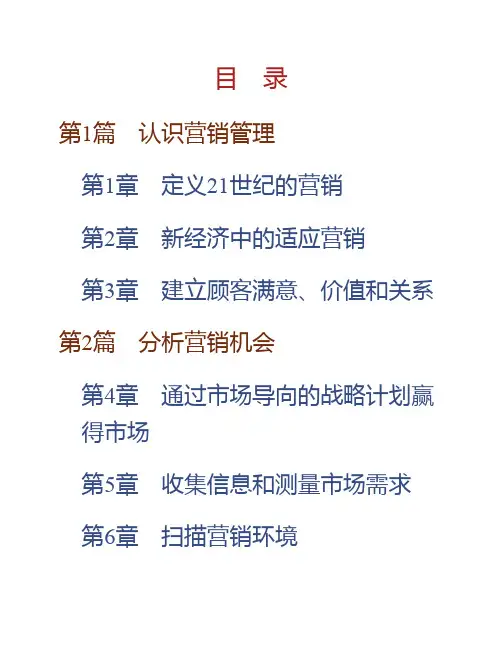
目 录第1篇 认识营销管理第1章 定义21世纪的营销第2章 新经济中的适应营销第3章 建立顾客满意、价值和关系第2篇 分析营销机会第4章 通过市场导向的战略计划赢得市场第5章 收集信息和测量市场需求第6章 扫描营销环境第7章 分析消费者市场和购买行为第8章 分析企业市场与企业购买行为第9章 参与竞争第10章 辨认市场细分和选择目标市场第3篇 发展营销战略第11章 在产品生命周期中定位和差异化市场供应品第12章 开发新的市场供应品第13章 设计全球市场供应品第4篇 塑造市场供应品第14章 建立产品和品牌战略第15章 设计与管理服务第16章 开发定价战略与方案第5篇 管理和传送营销方案第17章 设计和管理价值网络及营销渠道第18章 管理零售、批发和市场物流第19章 管理整合营销传播第20章 管理广告、销售促进和直接营销第21章 管理销售力量第1篇 认识营销管理第1章 定义21世纪的营销一、营销辩论论点:“营销形成消费者的需要和欲望”对“营销仅仅是反映消费者的需要和欲望”。
答:需要是购买的第一个前提,描述了基本的人类要求,如食品、空气、水、服装、住所、娱乐、教育和文娱生活等;欲望是指人希望得到更深层次的需要的满足,是由需要派生出来的;需求是指针对特定产品的欲望,这种欲望必须满足两个条件:有支付能力并且愿意购买。
关于营销是创造需求还是满足需求,两种说法都有一定的合理性。
(1)营销形成消费者的需要和欲望。
这一论点着重强调了营销在刺激消费者购买方面的积极作用,营销能够影响消费者的需求和欲望,促成消费者的购买行为。
比如,创造营销就是指发现和解决顾客并没有提出要求、但他们会热情响应的问题,也就是公司比顾客走得更远一些。
例如,营销人员增强了消费者这样一个观念:一辆劳斯莱斯可以满足人们对社会地位的需要,于是有支付能力的人在这种增强了的欲望下产生购买。
从这一点出发,可以说营销活动对消费者的需求和欲望有直接的影响。
(2)营销仅仅是反映消费者的需求和欲望。
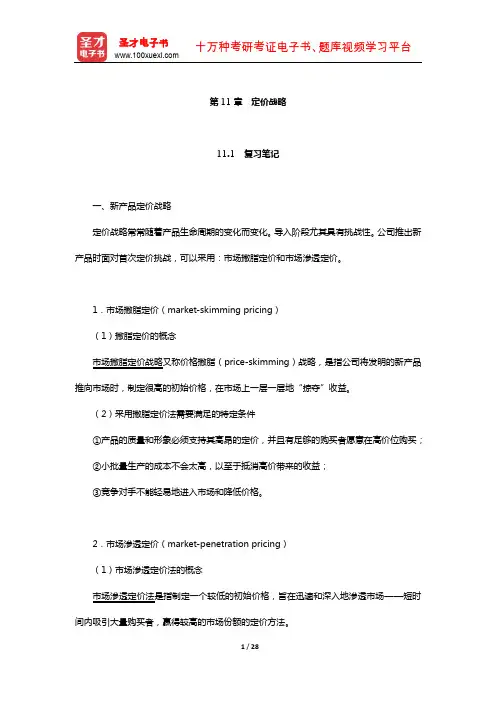
第11章定价战略11.1 复习笔记一、新产品定价战略定价战略常常随着产品生命周期的变化而变化。
导入阶段尤其具有挑战性。
公司推出新产品时面对首次定价挑战,可以采用:市场撇脂定价和市场渗透定价。
1.市场撇脂定价(market-skimming pricing)(1)撇脂定价的概念市场撇脂定价战略又称价格撇脂(price-skimming)战略,是指公司将发明的新产品推向市场时,制定很高的初始价格,在市场上一层一层地“掠夺”收益。
(2)采用撇脂定价法需要满足的特定条件①产品的质量和形象必须支持其高昂的定价,并且有足够的购买者愿意在高价位购买;②小批量生产的成本不会太高,以至于抵消高价带来的收益;③竞争对手不能轻易地进入市场和降低价格。
2.市场渗透定价(market-penetration pricing)(1)市场渗透定价法的概念市场渗透定价法是指制定一个较低的初始价格,旨在迅速和深入地渗透市场——短时间内吸引大量购买者,赢得较高的市场份额的定价方法。
(2)采用渗透定价需满足的条件①市场必须对价格高度敏感,从而低价格会产生更大的销售量和市场份额。
②产品的生产和分销成本必须随着销售量的增加而降低。
③低价必须有助于排斥竞争者,而且采取渗透定价法的公司必须保持其低价定位。
否则,价格优势仅仅是暂时的。
二、产品组合定价战略如果某产品是产品组合的一部分,其定价战略往往必须改变。
此时企业将寻求一组能够使产品组合整体利润最大化的价格。
常用的五种产品组合定价策略如表11-1所示。
表11-1 产品组合定价战略1.产品线定价(product line pricing)产品线定价是指对同一产品线内的不同产品差别定价。
在产品线定价中,管理者必须决定同一条产品线中不同产品的价格差距。
确定同一产品线中不同产品之间的价格差距,应该考虑不同产品之间的成本差异。
更重要的是,应该反映顾客对不同产品属性的感知价值。
2.备选产品定价(optional-product pricing)备选产品定价是指为与主要产品一起出售的选择性产品或附件产品定价。
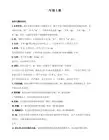
第1章营销:管理有价值的顾客关系1. “顾客价值和满意”是了解市场和消费者需求的五大核心概念之一,其他四项核心概念是什么?这五个概念中有没有一个概念比其他概念更重要?说出支持你答案的理由。
答:(1 )其他四个核心概念是:①需要、欲望和需求:②营销供给物(产品、服务和体验):③交换和关系:④市场。
它们与“顾客价值和满意”共同构成了了解市场和消费者需求的五大核心概念,其具体定义如下:需要(need )是指人们感到缺乏的一种状态,包括:对食物、衣服、保暖和安全的基本物质需要:对归属感和情感的社会需要:对知识和自我实现的个人需要:等等。
这些需要不是营销员创造的,而是人类所固有的。
欲望(want )是由需要派生出来的一种形式,它受社会文化和人们个性的限制。
当考虑到支付能力的时候,欲望就转换为需求(demand )。
营销供给物(marketing offer)是提供给某个市场未满足某种需要和欲望的产品、服务、信息和体验的组合。
交换(exchange )是指从他人那里取得想要的物品,同时以某种物品作为回报的行为。
市场(market )指某种产品的实际购买者和潜在购买者的集合。
这些购买者都具有某种欲望或需要,并且能够通过交换得到满足。
( 2 )这五个概念,并没有哪个明显的比另外的概念更重要,但如果非要选择一个最为重要的概念出来,那么可以认为“市场”这一概念是重中之重。
因为市场是所有营销任务的最基本的关注点和目标。
而营销的核心就是基于这样的一个理念:存在一个市场,它是某种产品的实际购买者和潜在购买者的集合,这些购买者都具有某种欲望或需要,并且能够通过交换得到满足。
2. 比较下列两种营销管理理念:“推销观念”和“营销观念”。
你能举出一个仍然把“推销观念”作为营销管理理念的市场或市场类型吗?答:( 1 )推销观念(selling concept )的基本假设是:如果组织不进行大规模的促销和推销,顾客就不会购买足够多的产品。
科特勒市场营销第十一章习题与答案Chapter 11 Pricing Strategies1) Companies facing the challenge of setting prices for the first time can choose between two broad strategies: market-penetration pricing and ________.A) market-level pricingB) market-competitive pricingC) market-skimming pricingD) market-price liningE) market-price fillingAnswer: CDiff: 2 Page Ref: 312Skill: ConceptObjective: 11-12) Of the following, which statement would NOT support a market-skimming policy for a new product?A) The product's quality and image support its higher price.B) Enough buyers want the products at that price.C) Competitors are not able to undercut the high price.D) Competitors can enter the market easily.E) C and DAnswer: DDiff: 3 Page Ref: 312Skill: ConceptObjective: 11-13) A firm is using ________ when it charges a high, premium price for a new product with the intention of reducing the price in the future.A) price skimmingB) trial pricingC) value pricingD) market-penetration pricingE) prestige pricingAnswer: ADiff: 2 Page Ref: 312Skill: ConceptObjective: 11-14) A marketer must be familiar with the five major product mix pricing situations. Which of the following is NOT one of them?A) product line pricingB) optional-product pricingC) captive-product pricingD) unbundled product pricingE) by-product pricingAnswer: DDiff: 3 Page Ref: 313Skill: Concept5) A challenge for management in product line pricing is to decide on the price steps between the ________.A) various products in a lineB) product mixesC) product groupingsD) product linesE) various target marketsAnswer: ADiff: 2 Page Ref: 313Skill: ConceptObjective: 11-26) HiPoint Telephone Company uses two-part pricing for itslong-distance call charges. Because this is a service, the price is broken into a fixed rate plus a ________.A) fixed rate usageB) variable usage rateC) standard usage rateD) market usage rateE) none of the aboveAnswer: BDiff: 1 Page Ref: 315Skill: ConceptObjective: 11-27) Which of the following is NOT a price adjustment strategy?A) segmented pricingB) promotional pricingC) free samplesD) geographical pricingE) seasonal pricingAnswer: CDiff: 2 Page Ref: 315Skill: ConceptObjective: 11-38) Service Industries, Inc., plans to offer a price-adjustment strategy in the near future. They could consider each of the following EXCEPT ________.A) discount and allowance pricingB) segmented pricingC) physiological pricingD) promotional pricingE) location pricingAnswer: CDiff: 2 Page Ref: 315Skill: Concept9) A quantity discount is a price reduction to buyers who purchase ________.A) frequentlyB) large volumesC) close outsD) inferior merchandiseE) superior merchandiseAnswer: BDiff: 2 Page Ref: 316Skill: ConceptObjective: 11-310) Quantity discounts provide an incentive to the customer to buy ________.A) more products or services from a variety of sellersB) less from another competitorC) more from one given seller, rather than from many different sourcesD) more than he or she needsE) bundled merchandiseAnswer: CDiff: 2 Page Ref: 316Skill: ConceptObjective: 11-311) Which of the following conditions should exist for segmented pricing to be an effective strategy?A) The market must be able to be segmented.B) The segments must show different degrees of demand.C) Competitors can't undersell in the segment being chargedthe higher price.D) All of the above.E) None of the above.Answer: DDiff: 2 Page Ref: 317Skill: ConceptObjective: 11-312) Consumers usually perceive higher-priced products as ________.A) not within reach of most peopleB) having a higher qualityC) having high profit marginsD) popular brandsE) being in the introductory stage of the product life cycleAnswer: BDiff: 2 Page Ref: 317Skill: ConceptObjective: 11-313) Michael and John both own leather jackets and are currently shopping for two new ones. They both have prices in mind and refer to them when shopping. These prices are termed ________.A) psychological pricesB) reference pricesC) comparison pricesD) price pointsE) skimmed pricesAnswer: BDiff: 2 Page Ref: 319Skill: ConceptObjective: 11-314) All of the following are typical ways a reference price might be formed in a buyer's mind EXCEPT ________.A) noting current pricesB) remembering past pricesC) assessing the buying situationD) comparing it to a new productE) influences from sellersAnswer: DDiff: 2 Page Ref: 319Skill: ConceptObjective: 11-315) What type of pricing is being used when a company temporarily prices it product below the list price or even below cost to create buying excitement and urgency?A) segmented pricingB) psychological pricingC) referent pricingD) promotional pricingE) dynamic pricingAnswer: DDiff: 1 Page Ref: 320Skill: ConceptObjective: 11-316) Promotional pricing can have all of the following adverse effects EXCEPT ________.A) creating deal-prone customersB) eroding the brand's value in the eyes of customersC) giving pricing secrets away to competitorsD) becoming addicting to both the customer and businessE) instigating industry price warsAnswer: CDiff: 2 Page Ref: 320Skill: ConceptObjective: 11-317) Durango China Company charges all customers within a given geographical area a single total price. The more distant the area, the higher the price. This is ________.A) freight-absorption pricingB) zone pricingC) uniform-delivered pricingD) FOB-origin pricingE) bulk rate pricingAnswer: BDiff: 2 Page Ref: 321Skill: ConceptObjective: 11-318) Which of the following is the opposite of FOB-origin pricing?A) basing-point pricingB) freight-absorption pricingC) uniform-delivered pricingD) freight-absorption pricingE) zone pricingAnswer: CDiff: 3 Page Ref: 321Skill: ConceptObjective: 11-319) Freight-absorption pricing is used for ________ and ________.A) market penetration; higher profit marginsB) holding on to increasingly competitive markets; higher profit marginsC) market penetration; holding on to increasingly competitive marketsD) generating temporary higher profits; discouraging competitorsE) services; installationsAnswer: CDiff: 3 Page Ref: 321Skill: ConceptObjective: 11-320) When a company charges the same rate to ship a product anywhere in the United States, it is using which form of geographic pricing?A) F.O.B. deliveredB) F.O.B. factoryC) F.O.B. originD) uniform deliveredE) basing-pointAnswer: DDiff: 1 Page Ref: 321Skill: ConceptObjective: 11-321) When pricing internationally, most companies adjust their prices to reflect ________.A) local market conditionsB) cost considerationsC) local laws and regulationsD) exchange-rate fluctuationsE) all of the aboveAnswer: EDiff: 2 Page Ref: 323AACSB: Multicultural and DiversitySkill: ConceptObjective: 11-322) Most companies that conduct international business ________ to ________.A) adjust their prices; take local market conditions into considerationB) use promotional pricing; create excitement in new marketsC) use geographical pricing; reduce delivery costsD) set a uniform price; maintain a consistent product imageE) initiate price cuts; compensate for import tariffs and taxesAnswer: ADiff: 2 Page Ref: 323AACSB: Multicultural and DiversitySkill: ConceptObjective: 11-323) When a competitor cuts its price, a company is most likely to decide to ________ if it believes it will not lose much market share or would lose too much profit by cutting its own price.A) reduce its production costsB) reduce its marketing costsC) maintain its current prices and profit marginD) increase its marketing budget to raise the perceived value of the productE) increase its production costs to improve the quality of the productAnswer: CDiff: 2 Page Ref: 326Skill: ConceptObjective: 11-424) When faced with a competitor who has cut its product's price, which of the following is typically the most efficient way for a company to maintain its own price but raise the perceived value of its offer?A) improving the quality of the productB) introducing a higher-priced premium brandC) altering the company's marketing communicationsD) bundling the offer with add-onsE) distributing the product through less costly channelsAnswer: CDiff: 3 Page Ref: 326Skill: ConceptObjective: 11-425) The Sherman, Clayton, and Robinson-Patman Acts are all federal laws that were enacted to curb the formation of ________.A) monopoliesB) oligopoliesC) competitive marketsD) international marketsE) limited partnershipsAnswer: ADiff: 2 Page Ref: 327AACSB: Ethical ReasoningSkill: ConceptObjective: 11-426) When sellers set prices after talking to competitors andengaging in collusion, they are involved in ________.A) predatory pricingB) discriminatory pricingC) price-fixingD) skimming pricingE) penetration pricingAnswer: CDiff: 2 Page Ref: 328AACSB: Ethical ReasoningSkill: ConceptObjective: 11-427) Price discrimination is legal under which of the following conditions?A) when a manufacturer and reseller have agreed upon a specified retail price for a productB) when a manufacturer sells to retailers in different marketsC) when a seller can prove its costs are different when selling to different retailersD) when a seller advertises prices that are not actually available to consumersE) when a seller has not communicated with competitors before announcing pricesAnswer: CDiff: 3 Page Ref: 330AACSB: Ethical ReasoningSkill: ConceptObjective: 11-428) Mark's Markers, a manufacturer of color markers, has required its dealers to charge a specified retail price for its markers. Mark's is most likely guilty of ________.A) price-fixing。
第十一章促销策略
1. 影响促销组合选择的因素有哪些?
答:影响促销组合选择的因素有促销目标、产品特点、产品生命周期、市场特点、促销策略、其他营销因素。
2. 简述人员推销的基本流程。
答:人员推销的基本流程是寻找顾客、接洽准备、接近顾客、推销面谈、处理异议、达成交易、跟踪服务。
3. 影响广告媒体选择的主要因素有哪些?
答:影响广告媒体选择的主要因素有消费者的媒体习惯、媒体的传播范围、商品的特性、媒体性质、媒体成本。
4. 一个完整的营业推广方案主要包括哪些内容?
答:一个完整的营业推广方案主要包括营业推广目标、营业推广的对象、营业推广的工具、营业推广的途径、营业推广的时机、营业推广的期限、营业推广的经费预算。
5. 公共关系促销的步骤有哪些?
答:公共关系促销的步骤有市场调查研究、确定公关目标、信息交流、公关效果评估。
市场营销学课后练习题及完整答案第一章1.市场营销:市场营销是(个人和组织)对货物、劳务和理念(或主意、计策)的构想、定价、促销和分销制定计划并予以执行的价值创造过程,以创造达到个人和组织的目标的交换2.服务的基本特征:无形性、不可分离性、不一致性、不可储存性3.营销组合要素(4P):Product(产品)、price(价格)、place(分销)、promotion(促销)4.需要(needs):人们感到没有得到某些基本满足的状态欲望(wants):人们想得到基本需要的具体满足物的愿望需求(demands):建立在有能力购买并且愿意购买的基础上的对某个具体商品或服务的欲望5.顾客传递价值(customer delivered value)价值(value)= 总利益(benefit) -总成本(cost)总利益:产品、服务、人员、形象;总成本:货币、时间、体力、精神6.满意、忠诚:顾客满意(customer satisfaction):产品或服务的实际绩效≥预期绩效顾客忠诚(customer loyalty):消费者反复购买特定品牌或特定企业产品的倾向7.营销概念的演变生产导向(19世纪末-20世纪初)—消费者购买特性:供不应求,卖方市场,消费者只关心能否以较低的价格买到产品—企业的任务:增加生产,改善生产和流通效率,降低成本销售导向(20世纪30-40年代)—消费者购买特性:供大于求,从买方市场向卖方市场转移,消费者抵触消费—企业的任务:通过人员推销和广告宣传进行高压式的“硬卖”营销导向(20世纪50-60年代)—消费者购买特性:完全的买方市场,消费者需求多样化、个性化,消费者购买能够最大限度地满足自身需求的产品—企业的任务:从市场需求出发,比竞争者更有效地满足消费者的需要社会营销导向(20世纪70年代-)—消费者购买特性:消费者关心健康、环境和企业伦理问题—企业的任务:不仅考虑消费者的需要,而且还考虑消费者和社会的长远利益8.营销战略:在特定的市场环境下针对目标顾客进行最有效的4P组合通过顾客满意创造附加价值的过程9.市场营销的基本框架(E-OSTP-4P)第二章1.营销环境:影响企业生存与发展、制约企业营销决策的内外部各种因素和力量的集合2.营销环境的分类:宏观环境与微观环境;内部环境与外部环境3.宏观环境构成要素:人口、经济、自然、技术、政治法律、社会文化4.微观环境构成要素:企业内部职能部门、供应商、营销中介、顾客、竞争者、公众5.企业内部环境构成要素:企业内部职能部门6.企业外部环境构成要素:人口、经济、自然、技术、政治法律、社会文化、供应商、营销中介、顾客、竞争者、公众7.SWOT分析第三章1.波特的五种竞争力量模型2.品牌竞争者:同一行业内以相似的价格提供类似产品或服务的企业行业竞争者:同一行业内生产同类产品(不同档次、型号)的企业一般竞争者:为满足相同需求而提供不同产品的企业广义竞争者:为争取同一笔资金而提供不同产品的企业3.战略群体(即战略集团):在某一行业内采取相同或相似战略的一组企业意义:确定最主要的竞争对手、选择较易进入的群体4.竞争者的反应:从容型竞争者:对某一特定攻击行为反应不迅速或不强烈选择型竞争者:对某些方面的进攻做出迅速反应,而对其他方面的进攻则无反应或反应不强烈凶暴型竞争者:对任何进攻都会做出迅速而强烈的反应随机型竞争者:对某一攻击行为的反应不可预知5.波特的三种竞争战略模型:成功企业—竞争优势—(成本领先、差异化、集中一点)6.成本领先战略:在行业内形成成本优势-实现方式(规模经济、低价获取生产要素、提高劳动效率、控制成本与管理费用)-带来的利益(提高市场占有率-低价销售、获得较高利润-同价销售、加强五种竞争力)-风险(成本领先地位无法保持-竞争者的模仿、技术变革,相对于差异化的地位丧失,成本集中的企业在部分市场上取得了更低成本)7.差异化战略:在行业内标新立异,形成独特性-带来的利益(价格溢价带来更多的利润、建立顾客的品牌忠诚、加强五种竞争力)-风险(差异化形象无法保持-竞争者的模仿、顾客的需求差异缩小,相对于低成本的地位丧失,差异化集中的企业在部分市场上取得了更加差异化的形象)8.集中一点战略:主攻某一个特定的细分市场(某一顾客群、某产品系列的某一细分区段、某一地区市场)-风险(竞争者的模仿-结构被破坏、需求消失,广设目标的企业占领了部分市场-该部分市场和其他部分市场的区别缩小、多品种生产的优势增加,新的集中一点的企业使产业市场更细分化)9.市场领先者(40%):在某一行业内拥有最大的市场份额、在营销组合方面起主导作用的某一大企业①阵地防御—以现有的不变的产品和市场防御竞争者的攻击—适用条件:环境变化不大—“静”与“变”的辩证统一:动态地维持现有的产品和市场(产品线延伸、产品改良、多元化)②侧翼防御—通过治理薄弱环节来防御竞争者乘虚而入或建立一些次要业务作为防御的前沿阵地(用以防御侧翼阵地的侧翼产品的质量保证)③以攻为守—在竞争对手发动进攻之前,先发制人,抢先进攻—指导思想:预防胜于治疗,防患于未然—实际攻击:对市场占有率达到某一危险高度的竞争者发动攻击、对市场上所有的竞争者进行全面攻击,使人人自危—心理战术:虚张声势④反击防御—受到竞争者的攻击时,以强硬的进攻行动加以迎击(正面迎击、侧翼反击、牵制攻击)⑤机动防御—未雨绸缪,向一些有潜力的新领域扩展,作为未来新的经济增长点和充当防御和进攻的中心(拓展新的细分市场、拓宽业务范围、多元化经营)⑥撤退防御(收缩防御)—有计划、主动地放弃一部分无法防守的市场和实力弱小的产品,以增援较强的领域市场挑战者(30%):在某一行业内名列第二、三名甚至名次更低的企业①正面进攻—集中全力直接攻击竞争对手的强势—条件:进攻者必须要在营销组合的主要方面绝对超过对手(3:1的优势)②侧翼进攻—以自身的相对优势去进攻竞争对手的薄弱环节(地理性侧攻、细分市场侧攻)③包围进攻—以更深的产品线或更广的市场来围攻竞争对手的阵地(产品围攻、市场围攻)④迂回进攻—避免在现阶段与竞争对手正面交锋,而是绕过过分拥挤的现有竞争市场来寻找开拓发展的新天地(产品多角化:发展与本行业无关的产品,市场多角化:以现有产品进入新的地区市场)⑤游击进攻—向竞争对手发动小范围、小规模、间歇性的进攻—目的:消耗对方的兵力,打击其士气,以期实现局势的某种变化市场追随者(20%):模仿市场领导者的市场营销组合要素的企业①紧跟其后:全面模仿领先者,只是品牌名称稍有区别②有选择追随:部分模仿领先者③改进:接受领先者的产品,并加以改进模仿:优点-投资少、利润高;缺点-路径依赖市场补缺者(10%):专门为被大企业忽略或不屑一顾的小市场提供有效服务的小企业成为服务于某一小市场的专家,并在该市场实施专业化策略:针对某些最终用户进行专业化经营、为某些特定顾客服务、只生产一条产品线的一种产品甚至其中的一种零件第四章1. 市场营销调研—概念:运用科学的方法,有目的、有计划地收集、整理和分析研究有关市场营销方面的信息,获得合乎客观事物发展规律的见解,提出解决问题的建议,供营销管理人员了解营销环境,发现机会与问题,并将其作为市场预测和营销决策的依据—意义:有利于制定科学的营销规划、有利于优化营销组合、有利于开拓新的市场2. 第一手资料及其收集方法观察法:通过观察和记录,获得行为和心理方面的感性资料—分类:根据被观察者是否知道自己在被观察中,分为公开与非公开观察;根据观察是由人还是由设备来进行,分为人与设备观察(设备:照相机、摄像机、交通流量计量器、单向行为观察仪、测录器等)实验法:把自然科学的实验求证法运用于营销研究。
第十一章渠道策略一、单项选择题一、商品在分销渠道上转移时,分销渠道成员要完成对商品的分类、分级、装配、包装和分级等工作,同时负责商品的运输和仓储,保证正常供货,这是分销渠道的()。
A.实体分配功能B.促销功能C.协议功能D.订货功能二、在商品沿着分销渠道进行所有权转移的同时,生意商品的资金也随之流动,渠道成员要不断地取得和支出资金,以使商品交易顺利进行,这是分销渠道的()。
A.实体分配功能B.促销功能C.付款功能D.融资功能3、分销渠道承担的大体功能是()。
A.实体分配功能B.承担风险功能C.付款功能D.商品所有权转移功能4、依照()划分,可将分销渠道划分为宽分销渠道与窄分销渠道。
A.中间机构级数B.分销渠道各层次同类中间商的数目C.分析渠道的中间环节D.分销渠道的层次五、由制造商、批发商和零售商所组成的统一体是()。
A.垂直分销系统B.水平式分销系统C.多渠道分销系统D.混合式分销系统六、以下不属于垂直分销系统的形式的是()。
A.公司式垂直分销系统B.股份制垂直分销系统C.管理式垂直分销系统D.合同式垂直分销系统7、汽车和某些要紧电器用具制造商常常采纳的一种分销渠道形式是()。
A.独家分销B.选择性分销C.密集性分销D.中间商分销八、一样来讲,选购品、特殊品和工业用品通常采取()。
A.独家分销B.选择性分销C.密集性分销D.中间商分销九、消费品中的便利品和工业品中供给品,通常采取()。
A.独家分销B.选择性分销C.密集性分销D.中间商分销10、对分销渠道的方案进行评估的标准不包括()。
A.经济性标准B.可控性标准C.便捷性标准D.适应性标准1一、市场物流的总本钱公式是()。
=T+FW+VW=T+FW+VW+S=FW+VW+S=T+VW+S1二、阻碍定货点决策因素不包括()。
A.订货前置时间B.市场占有率C.顾客平均购买率D.存货直接出货率13、假设某企业每一年需要某种生产材料400个单位,每次的定货费用为50元/单位,这种材料的单位年度维持费用为4元/单位?年,那么该生产材料的最正确定货量是()。
Chapter 11 Pricing Strategies1) Companies facing the challenge of setting prices for the first time can choose between two broad strategies: market-penetration pricing and ________.A) market-level pricingB) market-competitive pricingC) market-skimming pricingD) market-price liningE) market-price fillingAnswer: CDiff: 2 Page Ref: 312Skill: ConceptObjective: 11-12) Of the following, which statement would NOT support a market-skimming policyfor a new productA) The product's quality and image support its higher price.B) Enough buyers want the products at that price.C) Competitors are not able to undercut the high price.D) Competitors can enter the market easily.E) C and DAnswer: DDiff: 3 Page Ref: 312Skill: ConceptObjective: 11-13) A firm is using ________ when it charges a high, premium price for a new productwith the intention of reducing the price in the future.A) price skimmingB) trial pricingC) value pricingD) market-penetration pricingE) prestige pricingAnswer: ADiff: 2 Page Ref: 312Skill: ConceptObjective: 11-14) A marketer must be familiar with the five major product mix pricing situations. Which of the following is NOT one of themA) product line pricingB) optional-product pricingC) captive-product pricingD) unbundled product pricingE) by-product pricingAnswer: DDiff: 3 Page Ref: 313Skill: ConceptObjective: 11-25) A challenge for management in product line pricing is to decide on the pricesteps between the ________.A) various products in a lineB) product mixesC) product groupingsD) product linesE) various target marketsAnswer: ADiff: 2 Page Ref: 313Skill: ConceptObjective: 11-26) HiPoint Telephone Company uses two-part pricing for its long-distance call charges. Because this is a service, the price is broken into a fixed rate plus a ________.A) fixed rate usageB) variable usage rateC) standard usage rateD) market usage rateE) none of the aboveAnswer: BDiff: 1 Page Ref: 315Skill: ConceptObjective: 11-27) Which of the following is NOT a price adjustment strategyA) segmented pricingB) promotional pricingC) free samplesD) geographical pricingE) seasonal pricingAnswer: CDiff: 2 Page Ref: 315Skill: ConceptObjective: 11-38) Service Industries, Inc., plans to offer a price-adjustment strategy in the near future. They could consider each of the following EXCEPT ________.A) discount and allowance pricingB) segmented pricingC) physiological pricingD) promotional pricingE) location pricingAnswer: CDiff: 2 Page Ref: 315Skill: ConceptObjective: 11-39) A quantity discount is a price reduction to buyers who purchase ________.A) frequentlyB) large volumesC) close outsD) inferior merchandiseE) superior merchandiseAnswer: BDiff: 2 Page Ref: 316Skill: ConceptObjective: 11-310) Quantity discounts provide an incentive to the customer to buy ________.A) more products or services from a variety of sellersB) less from another competitorC) more from one given seller, rather than from many different sourcesD) more than he or she needsE) bundled merchandiseAnswer: CDiff: 2 Page Ref: 316Skill: ConceptObjective: 11-311) Which of the following conditions should exist for segmented pricing to be an effective strategyA) The market must be able to be segmented.B) The segments must show different degrees of demand.C) Competitors can't undersell in the segment being charged the higher price.D) All of the above.E) None of the above.Answer: DDiff: 2 Page Ref: 317Skill: ConceptObjective: 11-312) Consumers usually perceive higher-priced products as ________.A) not within reach of most peopleB) having a higher qualityC) having high profit marginsD) popular brandsE) being in the introductory stage of the product life cycleAnswer: BDiff: 2 Page Ref: 317Skill: ConceptObjective: 11-313) Michael and John both own leather jackets and are currently shopping for twonew o nes. They both have prices in mind and refer to them when s hopping. These prices are termed ________.A) psychological pricesB) reference pricesC) comparison pricesD) price pointsE) skimmed pricesAnswer: BDiff: 2 Page Ref: 319Skill: ConceptObjective: 11-314) All of the following are typical ways a reference price might be formed in abuyer's mind EXCEPT ________.A) noting current pricesB) remembering past pricesC) assessing the buying situationD) comparing it to a new productE) influences from sellersAnswer: DDiff: 2 Page Ref: 319Skill: ConceptObjective: 11-315) What type of pricing is being used when a company t emporarily prices it product below the list price or even below cost to create buying excitement and urgencyA) segmented pricingB) psychological pricingC) referent pricingD) promotional pricingE) dynamic pricingAnswer: DDiff: 1 Page Ref: 320Skill: ConceptObjective: 11-316) Promotional pricing can have all of the following adverse effects EXCEPT________.A) creating deal-prone customersB) eroding the brand's value in the eyes of customersC) giving pricing secrets away to competitorsD) becoming addicting to both the customer and businessE) instigating industry price warsAnswer: CDiff: 2 Page Ref: 320Skill: ConceptObjective: 11-317) Durango China Company charges all customers within a given geographical areaa single total price. The more distant the area, the higher the price. This is________.A) freight-absorption pricingB) zone pricingC) uniform-delivered pricingD) FOB-origin pricingE) bulk rate pricingAnswer: BDiff: 2 Page Ref: 321Skill: ConceptObjective: 11-318) Which of the following is the opposite of FOB-origin pricingA) basing-point pricingB) freight-absorption pricingC) uniform-delivered pricingD) freight-absorption pricingE) zone pricingAnswer: CDiff: 3 Page Ref: 321Skill: ConceptObjective: 11-319) Freight-absorption pricing is used for ________ and ________.A) market penetration; higher profit marginsB) holding on to increasingly competitive markets; higher profit marginsC) market penetration; holding on to increasingly competitive marketsD) generating temporary higher profits; discouraging competitorsE) services; installationsAnswer: CDiff: 3 Page Ref: 321Skill: ConceptObjective: 11-320) When a company charges the same rate to ship a product anywhere in the United States, it is using which form of geographic pricingA) deliveredB) factoryC) originD) uniform deliveredE) basing-pointAnswer: DDiff: 1 Page Ref: 321Skill: ConceptObjective: 11-321) When pricing internationally, most companies adjust their prices to reflect ________.A) local market conditionsB) cost considerationsC) local laws and regulationsD) exchange-rate fluctuationsE) all of the aboveAnswer: EDiff: 2 Page Ref: 323AACSB: Multicultural and DiversitySkill: ConceptObjective: 11-322) Most companies that conduct international business ________ to ________.A) adjust their prices; take local market conditions into considerationB) use promotional pricing; create excitement in new marketsC) use geographical pricing; reduce delivery costsD) set a uniform price; maintain a consistent product imageE) initiate price cuts; compensate for import tariffs and taxesAnswer: ADiff: 2 Page Ref: 323AACSB: Multicultural and DiversitySkill: ConceptObjective: 11-323) When a competitor cuts its price, a company i s most likely to decide to ________ if it believes it will not lose much market share or would lose too much profitby cutting its own price.A) reduce its production costsB) reduce its marketing costsC) maintain its current prices and profit marginD) increase its marketing budget to raise the perceived value of the productE) increase its production costs to improve the quality of the productAnswer: CDiff: 2 Page Ref: 326Skill: ConceptObjective: 11-424) When faced with a competitor who has cut its product's price, which of thefollowing is typically the most efficient way for a company to maintain its ownprice but raise the perceived value of its offerA) improving the quality of the productB) introducing a higher-priced premium brandC) altering the company's marketing communicationsD) bundling the offer with add-onsE) distributing the product through less costly channelsAnswer: CSkill: ConceptObjective: 11-425) The Sherman, Clayton, and Robinson-Patman Acts are all federal laws that were enacted to curb the formation of ________.A) monopoliesB) oligopoliesC) competitive marketsD) international marketsE) limited partnershipsAnswer: ADiff: 2 Page Ref: 327AACSB: Ethical ReasoningSkill: ConceptObjective: 11-426) When sellers set prices after talking to competitors and engaging in collusion, they are involved in ________.A) predatory pricingB) discriminatory pricingC) price-fixingD) skimming pricingE) penetration pricingAnswer: CAACSB: Ethical ReasoningSkill: ConceptObjective: 11-427) Price discrimination is legal under which of the following conditionsA) when a manufacturer and reseller have agreed upon a specified retail price for a productB) when a manufacturer sells to retailers in different marketsC) when a seller can prove its costs are different when selling to differentretailersD) when a seller advertises prices that are not actually available to consumersE) when a seller has not communicated with competitors before announcing prices Answer: CDiff: 3 Page Ref: 330AACSB: Ethical ReasoningSkill: ConceptObjective: 11-428) Mark's Markers, a manufacturer of color markers, has required its dealers tocharge a specified retail price for its markers. Mark's is most likely guilty of________.A) price-fixingB) retail price maintenanceC) price discriminationD) price collusionE) unfair price skimmingAnswer: BDiff: 2 Page Ref: 330AACSB: Ethical ReasoningSkill: ConceptObjective: 11-429) Pricing strategies tend to change and evolve as the average product passes through its life cycle.Answer: TRUEDiff: 1 Page Ref: 312Skill: ConceptObjective: 11-130) When using product bundle pricing, sellers combine several of their products and offer the bundle at an increased price for increased profit.Answer: FALSEDiff: 1 Page Ref: 315Skill: ConceptObjective: 11-232) A seasonal discount is a price reduction to buyers who buy merchandise or services while they are in season.Answer: FALSEDiff: 2 Page Ref: 316Skill: ConceptObjective: 11-333) Segmented pricing is known by other names; two of the most common are revenue management and yield management.Answer: TRUEDiff: 2 Page Ref: 317Skill: ConceptObjective: 11-334) The frequent use of promotional pricing can lead to industry price wars.Answer: TRUEDiff: 2 Page Ref: 320Skill: ConceptObjective: 11-335) The FOB-origin pricing strategy means that the goods sold are placed free onboard a carrier. At that point the title and responsibility pass to the customer, who pays the freight from the factory to the destination.Answer: TRUEDiff: 3 Page Ref: 321Skill: ConceptObjective: 11-336) When Redman's Variety raised their store prices 40 percent and then ran a 20percent off sale, Redman's was guilty of deceptive pricing.Answer: TRUEDiff: 2 Page Ref: 330AACSB: Ethical ReasoningSkill: ApplicationObjective: 11-437) Companies b ringing out a new p roduct can choose between two pricing strategies. What are they And please try to distinguish between the two (List the requirements for using these strategies).Answer: Market skimming is used to skim revenues layer by layer from the marketby entering the market with high initial prices. The product's quality and imagemust support its higher price, and enough buyers must want the product at that price. The costs of producing a smaller volume cannot be so high that they cancel theadvantage of charging more. Competitors should not be able to enter the marketeasily and undercut the high price. Market penetration is used to penetrate themarket quickly and deeply to attract a large number of buyers quickly and win alarge market share by setting a low price initially when it enters the market. The market must be highly price sensitive so that a low price produces more market growth. Production and distribution costs must fall as sales volume increases. Also, thelow price must help keep out competition and be maintained over time.Diff: 2 Page Ref: 312-313AACSB: Analytic SkillsSkill: ApplicationObjective: 11-1。